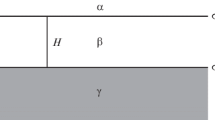Abstract
The paper deals with the description of the melting phenomena in thin films with surfaces. The model is based on the Lindemann criterion applied to the mean square displacements of atoms from their equilibrium positions at the surface and inside the sample. The harmonic approximation for the interaction potential is taken into account, however, the force effective parameters are evaluated by the elastic constants whose temperature and pressure dependence allows us to consider the mean square displacements at the pseudoharmonic level. The discussion of the results shows that the film starts to melt on the surface at the temperature lower than the melting temperature. This effect corresponds to the surface melting whose main properties can be predicted. Moreover, a new type of melting kinetics is interpreted.
Similar content being viewed by others
References
Nakaya U. and Matsumoto A.: J. Colloid. Sci.9 (1954) 41.
Faraday M.: Proc. Royal Soc. London10 (1860) 40.
Tammann G.: Z. Phys. Chem.68 (1910) 205.
Stranski I.N.: Z. Phys.119 (1942) 22.
Nenov D.:in Progress in Crystal Growth and Characterisation, Pergamon Press, Oxford, 1984.
Stock K.D. and Menzel E.: Surf. Sci.61 (1976) 272.
Nenow D., Pavlovska A., and Karl N.: J. Cryst. Growth67 (1984) 587.
Trayanov A. and Tosatti E.: Phys. Rev. B38 (1988) 6961.
Lipowsky R. and Speth W.: Phys. Rev. B28 (1983) 3983.
Pluis B. Frenken D., and van der Veen J.F.: Surf. Sci.239 (1990) 282.
Pietronero L. and Tossati E.: Solid State Commun.32 (1979) 255.
Lindemann F.A.: Z. Phys.14 (1910) 609.
Wojtczak L.: Solid State Phys. B23 (1967) K163.
Wojtczak L.: Thin Solid Films4 (1969) 229.
Malinowska-Adamska C.: Phys. Status Solidi B143 (1987) 63.
Kittel C.: Introduction to Solid State Physics, John Wiley and Sons, New York, 1956.
Pluis B.: Surface-Induced Melting of Lead (Thesis), Rijksuniversiteit te Leiden, The Niderlands, 1990.
Pluis B., Taylor T.N., Frenkel D., and van der Ween J.F.: Phys. Rev. B40 (1989) 1353.
Author information
Authors and Affiliations
Additional information
Devoted to the memory of the late Professor Luboš Valenta. He himself prepared the main part of the manuscript of the paper; the text, particularly the concluding remarks, has been adjusted by L. Wojtczak. The calculations leading to Fig. 6 have been performed by J. Czerbniak and T. Gwizdałła.
The paper was financially supported by the Project KBN 201949101/92-94.
Rights and permissions
About this article
Cite this article
Valenta, L. Theory of melting. Czech J Phys 46, 607–619 (1996). https://doi.org/10.1007/BF01690679
Received:
Issue Date:
DOI: https://doi.org/10.1007/BF01690679




